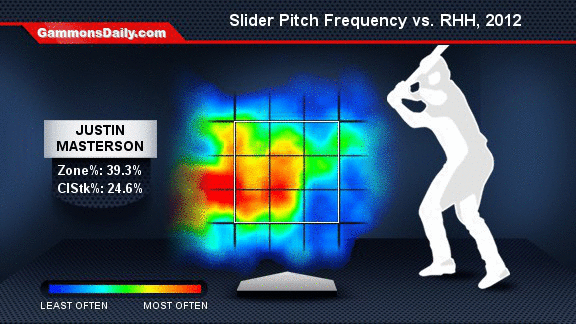Justin Masterson, Strikeout Fiend?
 Alec Dopp |
Alec Dopp |  Thursday, January 30, 2014 at 12:23PM
Thursday, January 30, 2014 at 12:23PM
Justin Masterson and the Cleveland Indians don't agree on a whole lot these days.
According to Paul Hoynes of Cleveland.com, the two sides remain several dollars apart in terms of perceived value for the 28-year-old righty, who's currently in his second year of arbitration eligibility. Masterson had vouched for a $11.8 million salary for the 2014 season, but the organization countered his offer for $8.05 million -- which is the "biggest difference among any unsigned player who filed for arbitration this winter," as reported by Hoynes. Consequently, the two parties have tucked away the paperwork for what would have been a multi-year contract extension, and instead will meet Feb. 20 in St. Petersburg, Fla. for their arbitration hearing.
Value discrepancies notwithstanding, there is one thing both sides can agree on: Masterson was really good last season. In his eighth season in the majors (and fifth since joining Cleveland in 2009), the former second-round pick posted career-bests in several categories, including (but not limited to): WHIP (1.20), complete games (3), shutouts (3) and strikeout rate (24.3%). The lattermost stat stands out the most when you look back at Masterson's past seasons, especially considering his very average 7.1 K/9 rating from 2008 to 2012. Suddenly, he struck out 9.1 batters per nine in one year's difference? How is this possible?
Improvements with Slider
| AVG | SLUG | Miss% | InPl% | Chas% | ClStk% | K% | |
|---|---|---|---|---|---|---|---|
| 1. 2012 | .197 | .317 | 38.8% | 30.2% | 28.0% | 31.2% | 39.2% |
| 2. 2013 | .108 | .176 | 41.1% | 27.0% | 30.4% | 37.5% | 51.6% |
Masterson's slider made improvements across the board over the past two seasons, both in terms of opponent averages against it and in 'swing-and-miss-ability'. One thing that stands out is batters' slugging percentage against the offering, which was a meger .176 last season -- the lowest among pitchers who threw at least 700 sliders last season. We also notice that opponents expanded the zone a bit more frequently against it (30.4% chase%), missed at a 41.1% clip (fifth-highest among qualified starters in 2013) and put just 27% of such sliders in play (also fifth-lowest among qualified arms).
The one aspect of the pitch that improved most last season, however, was its ability to generate called-strikes, increasing to 37.5% -- second to only Yu Darvish (38%) among righties who threw 800 sliders. How this factors in to Masterson's strikeout increase is simple: With better command of the pitch, more called strikes follow, which equates to more strikeouts.
Pitch Frequency Comparison

Masterson's strikeout rate against righties escalated from 23.3% in 2012 to 32% in 2013 (compared to increasing from 13.5% in 2012 to 19.4% in 2013 against lefties), and his improved slider had a big say in that boost. Notice the compressed pitch frequency of the offering between the two seasons; he seemed to have much better command of the offering, throwing in the strike zone 44.9% of the time last season compared to 39.3% in 2012.
Evidently, this increase swayed umps into giving him more calls, as his called strike rate escalated to a healthy 39.3% in contrast to his 24.6% mark two seasons ago. We shouldn't be too surprised by this increase, as there is a strong correlation between zone% and called strike% -- the more pitches you throw in the zone, the more called strikes you get with the offering. For example: The major-league average starter threw 46.5% of his sliders in the zone last season and accrued a 30% called-strike rate. But when you decrease that zone% to 39%, your called-strike rate falls to 23%. Throw 53% of your sliders in the zone, and your called-strike rate jumps to 35%. And when your called-strike rate goes, up so too does your strikeout rate.
It seems Masterson's better-commanded slider (especially against right-handed batters) was the key to his strikeout increase last season. Whether or not he can sustain this moving forward may well determine the length and amount of his next contract.
 Cleveland Indians,
Cleveland Indians,  Justin Masterson
Justin Masterson

Reader Comments